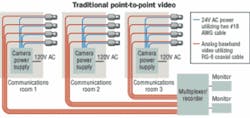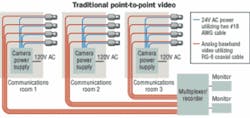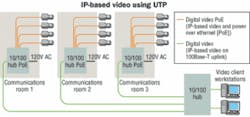The emergence of IP-based CCTV systems can affect the way you design their infrastructure.
The security industry is shifting the methods by which its systems communicate, from simple point-to-point protocols to Internet Protocol (IP)-based communications. Primarily, the closed-circuit television (CCTV) industry—which in the past has used a star-topology, coaxial distribution system moving analog video—is suddenly and rapidly shifting to IP-based communication over UTP cabling.
To understand why this is a historic opportunity to advance both industries, it is important to briefly review the evolution of CCTV technology. The CCTV industry's broad appeal arguably began when charge-coupled device (CCD) chips started replacing tube-based cameras. In addition to high cost, tube-based cameras had a lifespan of only a few years, and were notorious for image burn. The use of tube-based cameras was limited to a few highly critical locations. So, when CCD-based cameras hit the market, they were a huge improvement in reliability and cost.
In the mid-1980s, mass-manufactured CCDs swept the industry. Almost overnight, tube cameras were gone. CCD-based cameras became commonplace and were used liberally for both remote assessment of alarms and to watch over high-value items. With this leap in technology, guard forces became more effective as they could simultaneously monitor multiple locations separated by great distances. CCD-based camera systems could even be designed to prompt the user when it sensed something might require attention. Constantly watching large banks of monitors was not as necessary, and fewer people could more effectively monitor a large number of locations. Security integrators began installing cameras in nearly every building that had a security system. The coaxial cable was flying.
Historical distribution techniques
CCTV distribution had been a way to move a baseband analog signal from the camera to the viewer. Due to its low-loss characteristics and immunity to external interference, coaxial cable was the medium of choice. Coaxial is routed from each camera to the switcher, then to the monitor and recorder.
Additionally, until a few years ago, CCTV cameras required a method of synchronizing the video signal, which was done to prevent a video roll when the switcher changed from one video source to another. "Syncing" was accomplished either through distributing a sync signal over a separate coaxial cable or using the AC power frequency.
With the advent of digital-based switching and signal processing systems, the sync issue has all but disappeared; however, as a legacy of the now-extinct synchronization issue, CCTV cameras generally still use 24V AC for power. This has traditionally been delivered to the camera using a single pair of 18-AWG stranded wires.
Each fixed position interior camera requires one RG-59 coaxial and one 18-AWG two-conductor cable. These cables then route from the camera to the nearest low-voltage transformer, and the coaxial cable continues to the switcher. In large buildings, 100 cameras are not unusual, and the result can be a home-run coaxial bundle that is imposing, to say the least. Worse yet, when a camera is added in some distant location, a new cable is needed from the camera to the switcher. In a large building, the home-run installation can result in the majority of the installation cost.
Unaccustomed to structured cabling
The sudden appearance of IP-based cameras on the market has removed many installers from their collective coaxial comfort zone. The industry has transitioned from an analog baseband signal running on a home-run coaxial distribution, to building a fully digital 100Base-T switched network supporting 1 Mbit/sec MPEG 4 streams. In some cases, we are even delivering power(PoE) over the same UTP.
Information-technology (IT) managers, who in the past have balked at allowing security equipment in communications rooms, are rethinking their policy. IT departments, rather than banishing security to other locations, are instituting training sessions and assisting security installers with moves, adds, and changes to security sensors. Security, after all, usually does not have technicians on staff.
We do not want the security industry to become accustomed to installing separate UTP cabling components terminating in some place other than the communications room. If that happens, not only will UTP contractors suddenly have new competitors, but it may also be another decade before the opportunity arises to move toward a unified low-voltage cable plant.
Migration provides value
For the first time, security installers are being introduced to structured cabling. Security integrators are generally very IT-savvy and quickly will see the advantages of structured cabling. Soon, all security devices will make the transition to UTP. As a result, a giant opportunity arises for us to learn from each other and work together for the common good of both industries.
With assistance from security, deployment of a common zoned cabling system will make good economic sense. Not only are the costs associated with moves, adds, and changes reduced, but security costs are also reduced with the elimination of the home-run low-voltage cabling system.
Perhaps more importantly, security changes can be made quickly when they are supported by a zoned cabling system. Security can, for the first time, begin deploying sensors and cameras on a temporary basis to any location within the building for almost no cost. Using home-run techniques for this type of deployment with any regularity would prove too cost-prohibitive.
Suddenly, the security system becomes more adaptable and, therefore, more valuable. By combining the needs of voice, data, and video security, and potentially sharing installation budget on the front end, the overall system costs go down while both systems become more flexible and less expensive to maintain.
IT and security are at an important crossroads for both industries. Beginning a dialogue between departments, conducting training sessions, and reinforcing common goals are critical to moving both industries forward.
DONALD LATHAM is an associate partner with Newcomb & Boyd (Atlanta, GA; www.newcomb-boyd.com), focusing on the design of specialized building systems.


